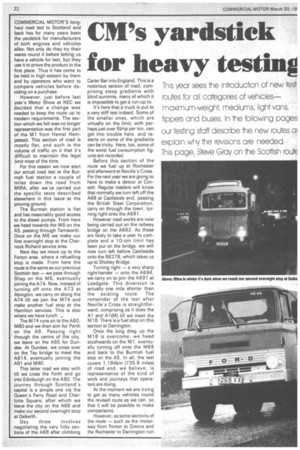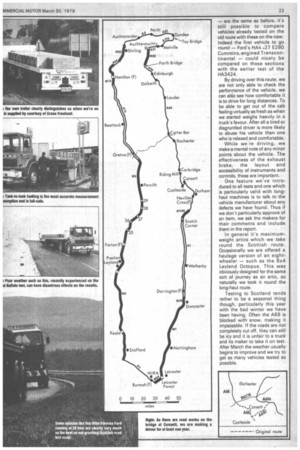CM's yardstick for heavy testing
Page 24

Page 25

If you've noticed an error in this article please click here to report it so we can fix it.
This year sees the introduction of new test routes for all categories of vehiclesmaximum-weight, mediums, light vans, tippers and buses. In ne following pages our testing staff describe ne new routes at explain why ne revisions are needed This page, Steve Gray on the Scotrish rourE
COMMERCIAL MOTOR'S longhaul road test to Scotland and
back has for many years been the yardstick for manufacturers of both engines and vehicles alike. Not only do they try their wares round it before letting us have a vehicle for test, but they use it to prove the product in the first place. Thus it has come to be held in high esteem by them and by operators who want to compare vehicles before deciding on a purchase.
However, just before last year's Motor Show at NEC we decided that a change was needed to keep the route up to modern requirements. The sec tion which we felt was no longer representative was the first part of the M1 from Hemel Hem pstead. This section of road is mostly flat, and such is the volume of traffic on it that it's difficult to maintain the legal limit most of the time.
For this reason we now start our actual road test at the Bur mah fuel station a couple of miles down the road from MIRA, after we've carried out the specific tests described elsewhere in this issue at the proving ground.
The Burmah station is flat and has reasonably good access to the diesel pumps. From here we head towards the M6 on the A5, passing through Tamworth.
Once on the MS we make our first overnight stop at the Charnock Richard service area.
Next day we move up to the Forton area, where a refuelling stop is made. From here the route is the same as our previous Scottish test — we pass through Shap on the M6, eventually joining the A74. Now, instead of turning off onto the A73 at Abington, we carry on along the A74 till we join the M74 and make another fuel stop at the Hamilton services. This is also where we have lunch.
The M74 runs on to the A80, M80 and we then aim for Perth on the A9. Passing right through the centre of the city, we leave on the ABS for Dun dee. At Dundee, we cross over on the Tay bridge to meet the A914, eventually joining the A91 and M90.
This latter road we stay with till we cross the Forth and go into Edinburgh on the A90. The journey through Scotland's capital is a simple one via the Queen's Ferry Road and Char lotte Square, after which we leave the city on the A68 and make our second overnight stop at Dalkeith.
Day three involves negotiating the very hilly sections of the A68 after climbing
Carter Bar into England. This is a notorious section of road, com prising steep gradients with blind summits, many of which it is impossible to get a run-up to.
It's here that a truck is put to a very stiff test indeed. Some of the smaller ones, which are
virtually on the limit, with perhaps just over 6bhp per ton, can
get into trouble here, and restarts on some of the gradients can be tricky. Here, too, some of the worst fuel consumption figures are recorded.
Before this section of the route we fuel up at Rochester
and afterward at Neville's Cross.
For the next year we are going to have to make a detour at Con sett. Regular readers will know that normally we turn left off the A68 at Castleside and, passing the British Steel Corporation, carry on through the town, turning right onto the A691.
However road works are now being carried out on the railway bridge on the A692. As these are likely to take a year to complete and a 10-ton limit has been put on the bridge, we will now turn left before Castleside onto the B6278, which takes us up to Shotley Bridge.
Turning right — a very sharp right-hander — onto the A694, we carry on to join the A691 at Leadgate. This diversion is actually one mile shorter than the existing route. The
remainder of the test after Neville's Cross is straightfor
ward, comprising as it does the Al and Al (M) till we meet the M18. There is a fuel stop on this section at Darrington.
Once the long drag up the M18 is overcome, we head southwards on the M 1, eventu ally turning off onto the M69 and back to the Burmah fuel stop on the A5. In all, the test covers 1,184km (735.9 miles) of road and, we believe, is representative of the kind of work and journeys that opera tors are doing.
At the moment we are trying to get as many vehicles round the revised route as we can, so that it will be possible to make comparisons.
However, as some sections of the route — such as the motorway from Forton to Gretna and the Rochester to Darrington run — are the same as before, it's still possible to compare vehicles already tested on the old route with these on the new. Indeed the first vehicle to go round — Ford's HA4 27 E290 Cummins, engined Transcontinental — could nicely be compared on these sections with the earlier test of the HA3424.
By driving over this route, we are not only able to check the performance of the vehicle, we can also see how comfortable it is to drive for long distances. To be able to get out of the cab feeling virtually as fresh as when we started weighs heavily in a truck's favour. After all a tired or disgruntled driver is more likely to abuse his vehicle than one who is relaxed and comfortable.
While we're driving, we make a mental note of any minor points about the vehicle, The effectiveness of the exhaust brake, the layout and accessibility of instruments and controls, these are important.
One feature we've introduced to all tests and one which is particularly valid with longhaul machines is to talk to the vehicle manufacturer about any defects we have found. Thus if we don't particularly approve of an item, we ask the makers for their comments and include them in the report.
In general it's maxim urnweight artics which we take round the Scottish route. Occasionally we are offered a haulage version of an eightwheeler — such as the 8x4 Leyland Octopus. This was obviously designed for the same sort of journey as an artic, so naturally we took it round the long-haul route.
Testing to Scotland tends rather to be a seasonal thing though, particularly this year with the bad winter we have been having. Often the A68 is blocked with snow, making it impassable. If the roads are not completely cut off, they can still be icy and it is unfair to a truck and its maker to take it on test. After March the weather usually begins to improve and we try to get as Many vehicles tested as possible.
























































































